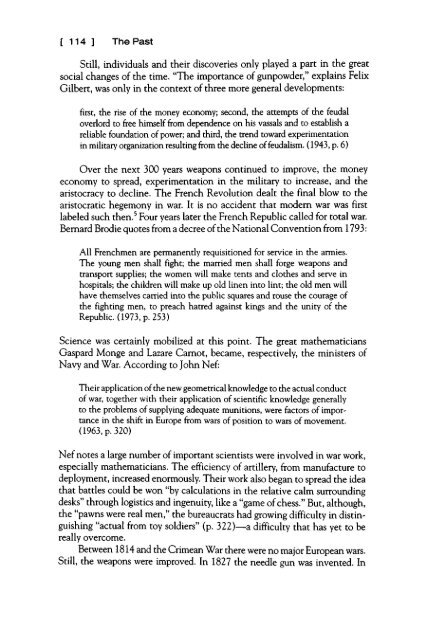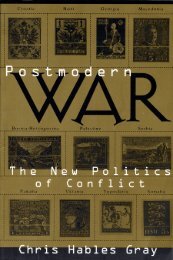6. Modern War - Chris Hables Gray
6. Modern War - Chris Hables Gray
6. Modern War - Chris Hables Gray
You also want an ePaper? Increase the reach of your titles
YUMPU automatically turns print PDFs into web optimized ePapers that Google loves.
[ 114 ] The Past<br />
Still, individuals and their discoveries only played a part in the great<br />
social changes of the time. "The importance of gunpowder," explains Felix<br />
Gilbert, was only in the context of three more general developments:<br />
first, the rise of the money economy; second, the attempts of the feudal<br />
overlord to freehimself fromdependence on his vassals and to establish a<br />
reliable foundation of power; and third, the trend toward experimentation<br />
in military organization resulting fromthe decline of feudalism. (1943, p. 6)<br />
Over the next 300 years weapons continued to improve, the money<br />
economy to spread, experimentation in the military to increase, and the<br />
aristocracy to decline. The French Revolution dealt the final blow to the<br />
aristocratic hegemony in war. It is no accident that modern war was first<br />
labeled such then. 5 Four years later the French Republic called for total war.<br />
Bernard Brodie quotes from a decree of the National Convention from 1793:<br />
All Frenchmen are permanently requisitioned for service in the armies.<br />
The young men shall fight; the married men shall forge weapons and<br />
transport supplies; the women will make tents and clothes and serve in<br />
hospitals; the children will make up old linen into lint; the old men will<br />
have themselves carried into the public squares and rouse the courage of<br />
the fighting men, to preach hatred against kings and the unity of the<br />
Republic. (1973, p. 253)<br />
Science was certainly mobilized at this point. The great mathematicians<br />
Gaspard Monge and Lazare Camot, became, respectively, the ministers of<br />
Navy and <strong>War</strong>. According to John Nef:<br />
Their application of the new geometrical knowledge to the actual conduct<br />
of war, together with their application of scientific knowledge generally<br />
to the problems of supplying adequate munitions, were factors of importance<br />
in the shift in Europe from wars of position to wars of movement.<br />
(1963, p. 320)<br />
Nef notes a large number of important scientists were involved in war work,<br />
especially mathematicians. The efficiency of artillery, from manufacture to<br />
deployment, increased enormously. Their work also began to spread the idea<br />
that battles could be won "by calculations in the relative calm surrounding<br />
desks" through logistics and ingenuity, like a "game of chess." But, although,<br />
the "pawns were real men," the bureaucrats had growing difficulty in distinguishing<br />
"actual from toy soldiers" (p. 322)—a difficulty that has yet to be<br />
really overcome.<br />
Between 1814 and the Crimean <strong>War</strong> there were no major European wars.<br />
Still, the weapons were improved. In 1827 the needle gun was invented. In








